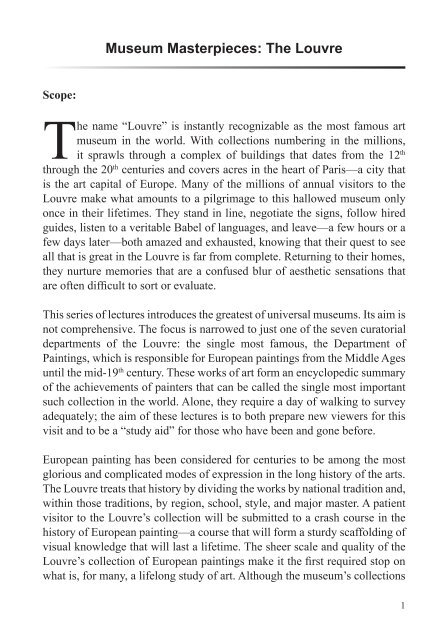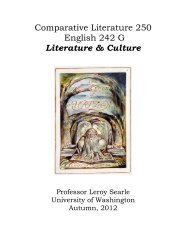You also want an ePaper? Increase the reach of your titles
YUMPU automatically turns print PDFs into web optimized ePapers that Google loves.
Scope:<br />
<strong>Museum</strong> <strong>Masterpieces</strong>: <strong>The</strong> <strong>Louvre</strong><br />
<strong>The</strong> name “<strong>Louvre</strong>” is instantly recognizable as the most famous art<br />
museum in the world. With collections numbering in the millions,<br />
it sprawls through a complex of buildings that dates from the 12 th<br />
through the 20 th centuries and covers acres in the heart of Paris—a city that<br />
is the art capital of Europe. Many of the millions of annual visitors to the<br />
<strong>Louvre</strong> make what amounts to a pilgrimage to this hallowed museum only<br />
once in their lifetimes. <strong>The</strong>y stand in line, negotiate the signs, follow hired<br />
guides, listen to a veritable Babel of languages, and leave—a few hours or a<br />
few days later—both amazed and exhausted, knowing that their quest to see<br />
all that is great in the <strong>Louvre</strong> is far from complete. Returning to their homes,<br />
they nurture memories that are a confused blur of aesthetic sensations that<br />
are often dif� cult to sort or evaluate.<br />
This series of lectures introduces the greatest of universal museums. Its aim is<br />
not comprehensive. <strong>The</strong> focus is narrowed to just one of the seven curatorial<br />
departments of the <strong>Louvre</strong>: the single most famous, the Department of<br />
Paintings, which is responsible for European paintings from the Middle Ages<br />
until the mid-19 th century. <strong>The</strong>se works of art form an encyclopedic summary<br />
of the achievements of painters that can be called the single most important<br />
such collection in the world. Alone, they require a day of walking to survey<br />
adequately; the aim of these lectures is to both prepare new viewers for this<br />
visit and to be a “study aid” for those who have been and gone before.<br />
European painting has been considered for centuries to be among the most<br />
glorious and complicated modes of expression in the long history of the arts.<br />
<strong>The</strong> <strong>Louvre</strong> treats that history by dividing the works by national tradition and,<br />
within those traditions, by region, school, style, and major master. A patient<br />
visitor to the <strong>Louvre</strong>’s collection will be submitted to a crash course in the<br />
history of European painting—a course that will form a sturdy scaffolding of<br />
visual knowledge that will last a lifetime. <strong>The</strong> sheer scale and quality of the<br />
<strong>Louvre</strong>’s collection of European paintings make it the � rst required stop on<br />
what is, for many, a lifelong study of art. Although the museum’s collections<br />
1







